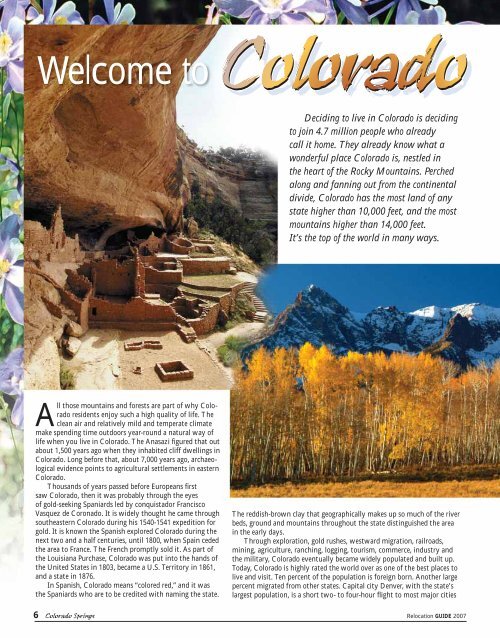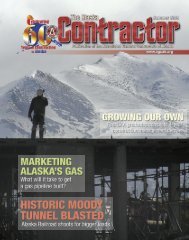Colorado Springs and El Paso County Relocation ... - Keep Trees
Colorado Springs and El Paso County Relocation ... - Keep Trees
Colorado Springs and El Paso County Relocation ... - Keep Trees
Create successful ePaper yourself
Turn your PDF publications into a flip-book with our unique Google optimized e-Paper software.
<strong>Colorado</strong><br />
Welcome to<br />
All those mountains <strong>and</strong> forests are part of why <strong>Colorado</strong><br />
residents enjoy such a high quality of life. The<br />
clean air <strong>and</strong> relatively mild <strong>and</strong> temperate climate<br />
make spending time outdoors year-round a natural way of<br />
life when you live in <strong>Colorado</strong>. The Anasazi fi gured that out<br />
about 1,500 years ago when they inhabited cliff dwellings in<br />
<strong>Colorado</strong>. Long before that, about 7,000 years ago, archaeological<br />
evidence points to agricultural settlements in eastern<br />
<strong>Colorado</strong>.<br />
Thous<strong>and</strong>s of years passed before Europeans fi rst<br />
saw <strong>Colorado</strong>, then it was probably through the eyes<br />
of gold-seeking Spaniards led by conquistador Francisco<br />
Vasquez de Coronado. It is widely thought he came through<br />
southeastern <strong>Colorado</strong> during his 1540-1541 expedition for<br />
gold. It is known the Spanish explored <strong>Colorado</strong> during the<br />
next two <strong>and</strong> a half centuries, until 1800, when Spain ceded<br />
the area to France. The French promptly sold it. As part of<br />
the Louisiana Purchase, <strong>Colorado</strong> was put into the h<strong>and</strong>s of<br />
the United States in 1803, became a U.S. Territory in 1861,<br />
<strong>and</strong> a state in 1876.<br />
In Spanish, <strong>Colorado</strong> means “colored red,” <strong>and</strong> it was<br />
the Spaniards who are to be credited with naming the state.<br />
Deciding to live in <strong>Colorado</strong> is deciding<br />
to join 4.7 million people who already<br />
call it home. They already know what a<br />
wonderful place <strong>Colorado</strong> is, nestled in<br />
the heart of the Rocky Mountains. Perched<br />
along <strong>and</strong> fanning out from the continental<br />
divide, <strong>Colorado</strong> has the most l<strong>and</strong> of any<br />
state higher than 10,000 feet, <strong>and</strong> the most<br />
mountains higher than 14,000 feet.<br />
It’s the top of the world in many ways.<br />
The reddish-brown clay that geographically makes up so much of the river<br />
beds, ground <strong>and</strong> mountains throughout the state distinguished the area<br />
in the early days.<br />
Through exploration, gold rushes, westward migration, railroads,<br />
mining, agriculture, ranching, logging, tourism, commerce, industry <strong>and</strong><br />
the military, <strong>Colorado</strong> eventually became widely populated <strong>and</strong> built up.<br />
Today, <strong>Colorado</strong> is highly rated the world over as one of the best places to<br />
live <strong>and</strong> visit. Ten percent of the population is foreign born. Another large<br />
percent migrated from other states. Capital city Denver, with the state’s<br />
largest population, is a short two- to four-hour fl ight to most major cities<br />
6 <strong>Colorado</strong> <strong>Springs</strong> <strong>Relocation</strong> GUIDE 2007

















